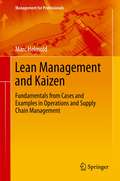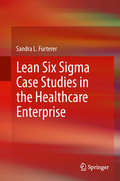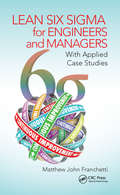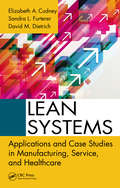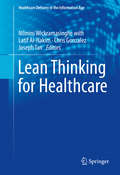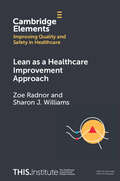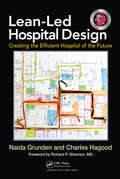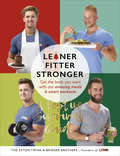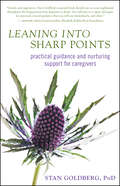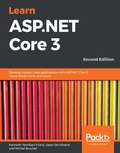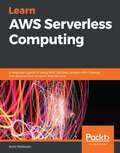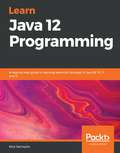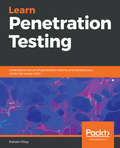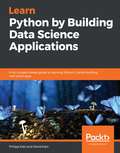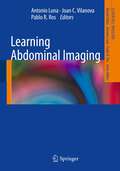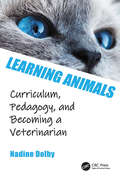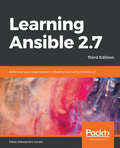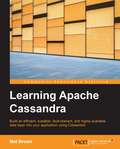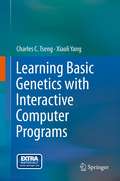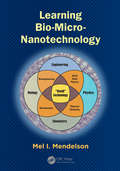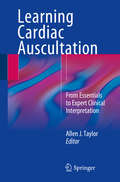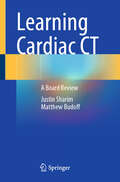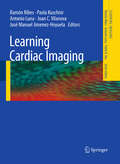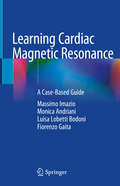- Table View
- List View
Lean Management and Kaizen: Fundamentals from Cases and Examples in Operations and Supply Chain Management (Management for Professionals)
by Marc HelmoldThe book provides a holistic and practical approach to lean management throughout the business value chain. The lean management framework and tools demonstrate the optimal design and use of methods, tools and principles for companies and organisations. The author describes comprehensively how lean management enables companies to concentrate on value-adding activities and processes to achieve a long-term, sustainable competitive advantage. A wealth of best practices, industry examples and case studies are used to reveal the diversity and opportunities of lean management methodologies, methods and principles. Moreover, the book shows how lean management principles are ultimately applied in industries like automotive, healthcare, education and services industries.
Lean Six Sigma Case Studies in the Healthcare Enterprise
by Sandra L. FurtererThis book provides a detailed description of how to apply Lean Six Sigma in the health care industry, with a special emphasis on process improvement and operations management in hospitals. The book begins with a description of the Enterprise Performance Excellence (EPE) improvement methodology developed by the author that links several methodologies including systems thinking, theory of constraints, Lean and Six Sigma to provide an enterprise-wide prioritization and value-chain view of health care. The EPE methodology helps to improve flow at the macro or value-chain level, and then identifies Lean Six Sigma detailed improvements that can further improve processes within the value-chain. The book also provides real-world health care applications of the EPE and Lean Six Sigma methodologies that showed significant results on throughput, capacity, operational and financial performance. The Enterprise Performance Excellence methodology is described, and also the Six Sigma DMAIC (Define-Measure-Analyze-Improve-Control) problem solving approach which is used to solve problems for health care processes as they are applied to real world cases. The case studies include a wide variety of processes and problems including: emergency department throughput improvement; operating room turnaround; operating room organization; CT imaging diagnostic test reduction in an emergency department; linen process improvement; implementing sepsis protocols in an emergency department; critical success factors of an enterprise performance excellence program.
Lean Six Sigma for Engineers and Managers: With Applied Case Studies
by Matthew John FranchettiThis book introduces Lean Six Sigma (LSS) to engineers and managers interested in implementing LSS at their organizations. The book provides a detailed roadmap and industry examples to aid readers in understanding and implementing the LSS system. This book discusses the LSS process to define improvement needs, measure current business performance, analyze performance results using statistical tools, improve business and financial results, and control peak business performance.
Lean Systems: Applications and Case Studies in Manufacturing, Service, and Healthcare
by Sandra L. Furterer David M. Dietrich Elizabeth A. CudneyLean Systems: Applications and Case Studies in Manufacturing, Service, and Healthcare details the various Lean techniques and numerous real-world Lean projects drawn from a wide variety of manufacturing, healthcare, and service processes, demonstrating how to apply the Lean philosophy. The book facilitates Lean instruction by supplying interactive
Lean Thinking for Healthcare
by Nilmini Wickramasinghe Joseph Tan Latif Al-Hakim Chris GonzalezA growing, aging population; the rise to epidemic proportions of various chronic diseases; competing, often overlapping medical technologies; and of course, skyrocketing costs compounded by waste and inefficiency - these are just a few of the multifarious challenges currently facing healthcare delivery. An unexpected source of solutions is being imported from the manufacturing sector: lean thinking. Lean Principles for Healthcare presents a conceptual framework, management principles, and practical tools for professionals tasked with designing and implementing modern, streamlined healthcare systems or overhauling faulty ones. Focusing on core components such as knowledge management, e-health, patient-centeredness, and collaborative care, chapters illustrate lean concepts in action across specialties (as diverse as nursing, urology, and emergency care) and around the globe. Extended case examples show health systems responding to consumer needs and provider realities with equal efficiency and effectiveness, and improved quality and patient outcomes. Further, contributors tackle the gamut of technological, medical, cultural, and business issues, among them: Initiatives of service-oriented architecture towards performance improvement Adapted lean thinking for emergency departments Lean thinking in dementia care through smart assistive technology Supporting preventive healthcare with persuasive services Value stream mapping for lean healthcare A technology mediated solution to reduce healthcare disparities Geared toward both how lean ideas can be carried out and how they are being used successfully in the real world, Lean Principles for Healthcare not only brings expert knowledge to healthcare managers and health services researchers but to all who have an interest in superior healthcare delivery.
Lean as a Healthcare Improvement Approach (Elements of Improving Quality and Safety in Healthcare)
by Sharon J. Williams Zoe RadnorLean is one of the most widely used improvement approaches in healthcare. With origins in manufacturing, it focuses on improving efficiency, eliminating waste, and streamlining processes. This Element provides an overview of the evidence for the use of Lean in healthcare, summarises the supporting tools and techniques, and emphasises the importance of developing an organisational culture committed to continuous improvement. The authors offer two case studies of attempts to implement Lean at scale, noting that, despite its popularity, implementation is not straightforward. Challenges include terminology that isn't always easy to grasp, perceived dissonances between the manufacturing origins of Lean based on repetitive, standardised, automated production and the human-centred world of healthcare, and problems with fidelity. The authors make the case that there is a lack of a robust evidence base for Lean and call for well-designed studies to advance the implementation of Lean and associated process improvement techniques in healthcare. This title is also available as open access on Cambridge Core.
Lean-Led Hospital Design: Creating the Efficient Hospital of the Future
by Naida Grunden Charles HagoodInstead of building new hospitals that import old systems and problems, the time has come to reexamine many of our ideas about what a hospital should be. Can a building foster continuous improvement? How can we design it to be flexible and useful well into the future? How can we do more with less?Winner of a 2013 Shingo Prize for Operational Excell
Lean-Led Hospital Design: Creating the Efficient Hospital of the Future
by Naida Grunden Charles HagoodLean-Led Hospital Design explains how hospitals can be built to increase patient safety and reduce wait times while eliminating waste, lowering costs, and easing some of healthcare‘s most persistent problems. It supplies a simplified timeline of architectural planning from start to finish to guide readers through the various stages of the Lean design development philosophy, including Lean architectural design and Lean work design. It includes examples from several real healthcare facility design and construction projects, as well as interviews with hospital leaders and architects.
Leaner, Fitter, Stronger: A Festive Survival Guide
by Tom Exton, James Exton, Max Bridger, Lloyd BridgerLeaning into Sharp Points: Practical Guidance and Nurturing Support for Caregivers
by Stan GoldbergWhether you’re coping with a loved one who has received a terminal diagnosis, has a long-term illness or disability, or suffers with dementia, caregiving is challenging and crucial. Those who face this responsibility, whether occasionally or 24/7, are brushing up against life’s sharpest point. In this book, Stan Goldberg offers an honest, caring, and comprehensive guide to those on this journey. Everyone wants to “do the right thing,” and this book provides the often-elusive how-to; from bedside etiquette to advice on initiating difficult conversations, caring for oneself while caring for another, navigating rapid changes in your loved one’s condition, and even offering “permission” for them to die. Goldberg’s stories demonstrate how to address the most difficult topics and will facilitate more open and useful communication and caregiving.
Learn ASP.NET Core 3: Develop modern web applications with ASP.NET Core 3, Visual Studio 2019, and Azure, 2nd Edition
by Jason De Oliveira Michel Bruchet Kenneth Yamikani FukiziA beginner's guide to building fully functioning web applications from scratch using the latest features of ASP.NET Core 3 and C# 8 Key Features Get to grips with the new features and APIs in ASP.NET Core 3, EF Core 3, and Blazor Create web APIs that integrate your applications with other systems and services Learn to deploy your web applications in new environments such as the cloud and Docker containers Book Description ASP.NET Core is an open source framework from Microsoft that makes it easy to build highly efficient and dynamic cross-platform web applications. Updated for the latest features of ASP.NET Core 3, this second edition will equip you with the skills you need to build powerful web applications. The book starts with an introduction to ASP.NET Core and its features, giving you a complete understanding of the framework. You will also learn how to set up your development environment with Visual Studio 2019 and build a fully functioning application from scratch. You'll then understand core concepts for building web applications such as Model View Controller (MVC), dependency injection, and WebSockets. As you advance, you'll discover how to use Entity Framework Core 3 to automate all database-related activities for your application. You will then build and document secure web APIs using security best practices to protect your web applications from threats and vulnerabilities. Finally, you will learn how to use Azure DevOps as a CI/CD tool to deploy and monitor your applications using Microsoft Azure, Amazon Web Services (AWS), and Docker. By the end of this book, you'll have the skills you need to develop efficient and robust web applications in ASP.NET Core 3. What you will learn Delve into basic and advanced ASP.NET Core 3 concepts with the help of examples Build an MVC web application and use Entity Framework Core 3 to access data Add web APIs to your web applications using RPC, REST, and HATEOAS Create a fully automated continuous integration and continuous delivery (CI/CD) pipeline using Azure DevOps Use Azure, Amazon Web Services, and Docker to deploy and monitor your applications Secure your web application from common attacks such as Cross-Site Scripting and SQL injection Explore client-side development using C# Razor components Who this book is for This book is for developers who want to build modern web applications with ASP.NET Core. The book will also be helpful for anyone working in infrastructure engineering and operations to monitor and diagnose problems during the runtime of ASP.NET Core 3.0 web applications. Although no prior understanding of ASP.NET or .NET Core is required, basic C# programming knowledge is assumed.
Learn AWS Serverless Computing: A beginner's guide to using AWS Lambda, Amazon API Gateway, and services from Amazon Web Services
by Scott PattersonBuild, deploy, test, and run cloud-native serverless applications using AWS Lambda and other popular AWS services Key Features Learn how to write, run, and deploy serverless applications in Amazon Web Services Make the most of AWS Lambda functions to build scalable and cost-efficient systems Build and deploy serverless applications with Amazon API Gateway and AWS Lambda functions Book Description Serverless computing is a way to run your code without having to provision or manage servers. Amazon Web Services provides serverless services that you can use to build and deploy cloud-native applications. Starting with the basics of AWS Lambda, this book takes you through combining Lambda with other services from AWS, such as Amazon API Gateway, Amazon DynamoDB, and Amazon Step Functions. You'll learn how to write, run, and test Lambda functions using examples in Node.js, Java, Python, and C# before you move on to developing and deploying serverless APIs efficiently using the Serverless Framework. In the concluding chapters, you'll discover tips and best practices for leveraging Serverless Framework to increase your development productivity. By the end of this book, you'll have become well-versed in building, securing, and running serverless applications using Amazon API Gateway and AWS Lambda without having to manage any servers. What you will learn Understand the core concepts of serverless computing in AWS Create your own AWS Lambda functions and build serverless APIs using Amazon API Gateway Explore best practices for developing serverless applications at scale using Serverless Framework Discover the DevOps patterns in a modern CI/CD pipeline with AWS CodePipeline Build serverless data processing jobs to extract, transform, and load data Enforce resource tagging policies with continuous compliance and AWS Config Create chatbots with natural language understanding to perform automated tasks Who this book is for This AWS book is for cloud architects and developers who want to build and deploy serverless applications using AWS Lambda. A basic understanding of AWS is required to get the most out of this book.
Learn Java 12 Programming: A step-by-step guide to learning essential concepts in Java SE 10, 11, and 12
by Nick SamoylovA comprehensive guide to get started with Java and gain insights into major concepts such as object-oriented, functional, and reactive programmingKey FeaturesStrengthen your knowledge of important programming concepts and the latest features in JavaExplore core programming topics including GUI programming, concurrency, and error handlingLearn the idioms and best practices for writing high-quality Java codeBook DescriptionJava is one of the preferred languages among developers, used in everything right from smartphones, and game consoles to even supercomputers, and its new features simply add to the richness of the language. This book on Java programming begins by helping you learn how to install the Java Development Kit. You will then focus on understanding object-oriented programming (OOP), with exclusive insights into concepts like abstraction, encapsulation, inheritance, and polymorphism, which will help you when programming for real-world apps. Next, you’ll cover fundamental programming structures of Java such as data structures and algorithms that will serve as the building blocks for your apps. You will also delve into core programming topics that will assist you with error handling, debugging, and testing your apps. As you progress, you’ll move on to advanced topics such as Java libraries, database management, and network programming, which will hone your skills in building professional-grade apps.Further on, you’ll understand how to create a graphic user interface using JavaFX and learn to build scalable apps by taking advantage of reactive and functional programming.By the end of this book, you’ll not only be well versed with Java 10, 11, and 12, but also gain a perspective into the future of this language and software development in general.What you will learnLearn and apply object-oriented principlesGain insights into data structures and understand how they are used in JavaExplore multithreaded, asynchronous, functional, and reactive programmingAdd a user-friendly graphic interface to your applicationFind out what streams are and how they can help in data processingDiscover the importance of microservices and use them to make your apps robust and scalableExplore Java design patterns and best practices to solve everyday problemsLearn techniques and idioms for writing high-quality Java codeWho this book is forStudents, software developers, or anyone looking to learn new skills or even a language will find this book useful. Although this book is for beginners, professional programmers can benefit from it too. Previous knowledge of Java or any programming language is not required.
Learn Penetration Testing: Understand the art of penetration testing and develop your white hat hacker skills
by Rishalin PillayGet up to speed with various penetration testing techniques and resolve security threats of varying complexityKey FeaturesEnhance your penetration testing skills to tackle security threatsLearn to gather information, find vulnerabilities, and exploit enterprise defensesNavigate secured systems with the most up-to-date version of Kali Linux (2019.1) and Metasploit (5.0.0)Book DescriptionSending information via the internet is not entirely private, as evidenced by the rise in hacking, malware attacks, and security threats. With the help of this book, you'll learn crucial penetration testing techniques to help you evaluate enterprise defenses.You'll start by understanding each stage of pentesting and deploying target virtual machines, including Linux and Windows. Next, the book will guide you through performing intermediate penetration testing in a controlled environment. With the help of practical use cases, you'll also be able to implement your learning in real-world scenarios. By studying everything from setting up your lab, information gathering and password attacks, through to social engineering and post exploitation, you'll be able to successfully overcome security threats. The book will even help you leverage the best tools, such as Kali Linux, Metasploit, Burp Suite, and other open source pentesting tools to perform these techniques. Toward the later chapters, you'll focus on best practices to quickly resolve security threats.By the end of this book, you'll be well versed with various penetration testing techniques so as to be able to tackle security threats effectivelyWhat you will learnPerform entry-level penetration tests by learning various concepts and techniquesUnderstand both common and not-so-common vulnerabilities from an attacker's perspectiveGet familiar with intermediate attack methods that can be used in real-world scenariosUnderstand how vulnerabilities are created by developers and how to fix some of them at source code levelBecome well versed with basic tools for ethical hacking purposesExploit known vulnerable services with tools such as MetasploitWho this book is forIf you’re just getting started with penetration testing and want to explore various security domains, this book is for you. Security professionals, network engineers, and amateur ethical hackers will also find this book useful. Prior knowledge of penetration testing and ethical hacking is not necessary.
Learn Python by Building Data Science Applications: A fun, project-based guide to learning Python 3 while building real-world apps
by David Katz Philipp KatsUnderstand the constructs of the Python programming language and use them to build data science projects Key Features Learn the basics of developing applications with Python and deploy your first data application Take your first steps in Python programming by understanding and using data structures, variables, and loops Delve into Jupyter, NumPy, Pandas, SciPy, and sklearn to explore the data science ecosystem in Python Book Description Python is the most widely used programming language for building data science applications. Complete with step-by-step instructions, this book contains easy-to-follow tutorials to help you learn Python and develop real-world data science projects. The “secret sauce” of the book is its curated list of topics and solutions, put together using a range of real-world projects, covering initial data collection, data analysis, and production. This Python book starts by taking you through the basics of programming, right from variables and data types to classes and functions. You'll learn how to write idiomatic code and test and debug it, and discover how you can create packages or use the range of built-in ones. You'll also be introduced to the extensive ecosystem of Python data science packages, including NumPy, Pandas, scikit-learn, Altair, and Datashader. Furthermore, you'll be able to perform data analysis, train models, and interpret and communicate the results. Finally, you'll get to grips with structuring and scheduling scripts using Luigi and sharing your machine learning models with the world as a microservice. By the end of the book, you'll have learned not only how to implement Python in data science projects, but also how to maintain and design them to meet high programming standards. What you will learn Code in Python using Jupyter and VS Code Explore the basics of coding – loops, variables, functions, and classes Deploy continuous integration with Git, Bash, and DVC Get to grips with Pandas, NumPy, and scikit-learn Perform data visualization with Matplotlib, Altair, and Datashader Create a package out of your code using poetry and test it with PyTest Make your machine learning model accessible to anyone with the web API Who this book is for If you want to learn Python or data science in a fun and engaging way, this book is for you. You'll also find this book useful if you're a high school student, researcher, analyst, or anyone with little or no coding experience with an interest in the subject and courage to learn, fail, and learn from failing. A basic understanding of how computers work will be useful.
Learning Abdominal Imaging
by Joan C. Vilanova Antonio Luna Pablo R. RosThis book is an ideal introduction to the use of radiology in imaging diseases of the liver, gallbladder and biliary system, pancreas, spleen, and gastrointestinal tract. Each of the ten chapters is devoted to a particular organ and contains ten illustrated case reports drawn from clinical practice. Common clinical situations and indications for imaging are reviewed, and clear descriptions are provided of the various imaging techniques that will assist in resolving diagnostic and therapeutic dilemmas. This book is recommended for medical students, residents, and inexperienced abdominal radiologists.
Learning Animals: Curriculum, Pedagogy and Becoming a Veterinarian
by Nadine DolbyWe are surrounded by thousands of animals, alive and dead. They are an intimate and ever-present part of our human lives. As a society, we privilege veterinarians as experts on these animals: they are our educators and teachers in what they say, what they do, and the decisions that they make. Yet, within the field of education, there is little research on the curriculum, pedagogy, and experiences of veterinary school and students. What do veterinarians learn in veterinary school? How do their experiences during those four years shape their perceptions of animals? How do the structures, curriculum, and pedagogy of veterinary college create and influence these experiences? Learning Animals opens up this conversation through an exploration of the complicated, fascinating and often painful stories of a cohort of veterinary students as they make their four-year journey from matriculation through graduation. The book examines how the experiences of veterinary students shape how humans relate to animals, from public policy and decision-making about the environment and animals slaughtered for food, to the most personal decisions about euthanizing companion animals. The first full-length, critical, qualitative study of the perspectives of our primary teachers about animals, this will be a thought-provoking read for those in the fields of both educational research and veterinary education.
Learning Ansible 2.7: Automate your organization's infrastructure using Ansible 2.7, 3rd Edition
by Fabio Alessandro LocatiUse Ansible to configure your systems, deploy software, and orchestrate advanced IT tasksKey FeaturesGet familiar with the fundamentals of Ansible 2.7Understand how to use Ansible Tower to scale your IT automationGain insights into how to develop and test Ansible playbooks Book DescriptionAnsible is an open source automation platform that assists organizations with tasks such as application deployment, orchestration, and task automation. With the release of Ansible 2.7, even complex tasks can be handled much more easily than before.Learning Ansible 2.7 will help you take your first steps toward understanding the fundamentals and practical aspects of Ansible by introducing you to topics such as playbooks, modules, and the installation of Linux, Berkeley Software Distribution (BSD), and Windows support. In addition to this, you will focus on various testing strategies, deployment, and orchestration to build on your knowledge. The book will then help you get accustomed to features including cleaner architecture, task blocks, and playbook parsing, which can help you to streamline automation processes. Next, you will learn how to integrate Ansible with cloud platforms such as Amazon Web Services (AWS) before gaining insights into the enterprise versions of Ansible, Ansible Tower and Ansible Galaxy. This will help you to use Ansible to interact with different operating systems and improve your working efficiency. By the end of this book, you will be equipped with the Ansible skills you need to automate complex tasks for your organization.What you will learnCreate a web server using Ansible Write a custom module and test it Deploy playbooks in the production environment Troubleshoot networks using Ansible Use Ansible Galaxy and Ansible Tower during deployment Deploy an application with Ansible on AWS, Azure and DigitalOceanWho this book is forThis beginner-level book is for system administrators who want to automate their organization's infrastructure using Ansible 2.7. No prior knowledge of Ansible is required
Learning Apache Cassandra
by Mat BrownIf you're an application developer familiar with SQL databases such as MySQL or Postgres, and you want to explore distributed databases such as Cassandra, this is the perfect guide for you. Even if you've never worked with a distributed database before, Cassandra's intuitive programming interface coupled with the step-by-step examples in this book will have you building highly scalable persistence layers for your applications in no time.
Learning Basic Genetics with Interactive Computer Programs
by Charles C. Tseng Xiaoli YangTraditionally, genetics laboratory exercises at the university level focus on mono- and dihybrid crosses and phenotypic analysis--exercises under traditional time, materials, and process constraints. Lately, molecular techniques such as gene cloning, polymerase chain reactions (PCR), and bioinformatics are being included in many teaching laboratories--where affordable. Human chromosome analysis, when present at all, has often been restricted to simple identification of chromosomes by number, through the usual "cut-and-paste" method. Although several online karyotyping (chromosome identification) programs have become available, they are not meaningful for studying the dynamics of the chromosome system, nor do they help students understand genetics as a discipline. The software that accompanies this book has been shown to be an ideal tool for learning about genetics, which requires a combination of understanding, conceptualization, and practical experience.
Learning Bio-Micro-Nanotechnology
by Mel I. MendelsonLearning Bio-Micro-Nanotechnology is a primer on micro/nanotechnology that teaches the vocabulary, fundamental concepts, and applications of micro/nanotechnology in biology, chemistry, physics, engineering, electronics, computers, biomedicine, microscopy, ethics, and risks to humankind. It provides an introduction into the small world with a low fo
Learning Cardiac Auscultation
by Allen J. TaylorThe book contains a series of core auscultation "lessons". All are case based and describe auscultation as it relates to a patient and in terms of the gold standard for interpretation of heart sounds. Auscultation is the term for listening to the internal sounds of the body, usually using a stethoscope. It is performed for the purposes of examining the circulatory system and respiratory system (heart sounds and breath sounds). As a topic it is one of the oldest in cardiology but its utility should never be underestimated. In this era of hugely expensive imaging tests, auscultation is a cornerstone of efficient diagnosis and therefore needs a fresh look. The core content of this book describes the search for diagnostic clues within patients' heart sounds and as such this book provides superb practical advice in the form of a series of clinical pearls reflecting what accurate diagnosis with auscultation can mean to patient prognosis and outcome. This often subtle but ultimately simple subject often produces complex results and these must be considered in light of modern next-level diagnostic methods and patient management.
Learning Cardiac CT: A Board Review
by Justin Sharim Matthew BudoffThis compact educational book provides a succinct review of the use of CT to investigate heart disease for those taking their Cardiac CT Boards. CT is an increasingly used imaging modality in cardiology with increasing numbers of patients undergoing the modality to diagnose coronary artery disease, and more practitioners (cardiologists, radiologists, and physicians-in-training, including cardiology and advanced imaging fellows) taking the Cardiac CT Board exam. Learning Cardiac CT: A Board Review provides a structured didactic review book targeting the Cardiac CT board exam. As such it will be of vital use to anyone taking their Cardiac CT Boards or looking for a practical and compact review of the use of CT in investigating cardiac disease.
Learning Cardiac Imaging
by Ramón Ribes Joan C. Vilanova Antonio Luna José Manuel Jimenez-Hoyuela Paola KuschnirThis book is an introduction to cardiac imaging. Written by radiologists, cardiologists, and nuclear medicine physicians in a user-friendly format, it provides the reader with a multidisciplinary selection of the most prevalent cardiac conditions. The book is subdivided into four sections: Cardiac Multislice CT, Echocardiography, Cardiac Magnetic Resonance and Nuclear Cardiology. Each chapter is presented with an introduction to the subspecialty and a selection of cases with illustrations, comments from clinical and radiological standpoints, and bibliographical recommendations.
Learning Cardiac Magnetic Resonance: A Case-Based Guide
by Massimo Imazio Monica Andriani Fiorenzo Gaita Luisa Lobetti BodoniThis book provides an easy-to-use guide, giving cardiologists and other physicians more confidence in training with and understanding cardiac magnetic resonance (CMR) in clinical daily practice. The case-based format promotes step-by-step learning and makes this book a helpful tool for students, residents and trainees in cardiology. An updated, comprehensive review of CMR diagnostic criteria is provided for all clinical cardiovascular applications of CMR in adult patients, from ischemic heart diseases to myocarditis, and from pericardial diseases to tumors, artifacts and incidental findings. CMR is an expanding imaging technique for cardiologists and radiologists alike. Despite several textbooks, manuals and dedicated texts, clinicians may still find it difficult to familiarize themselves with the exam and there are limited formats that provide easy access to the basic information (e.g. physics, specific applications) that are needed for training and clinical interpretation (especially case-based). By describing the basics of physics and methodology in a straightforward manner and providing meaningful clinical examples, this book will help all cardiologists dealing with cardiac imaging as well as doctors in training to quickly and accurately interpret CMR findings in their clinical practice.
